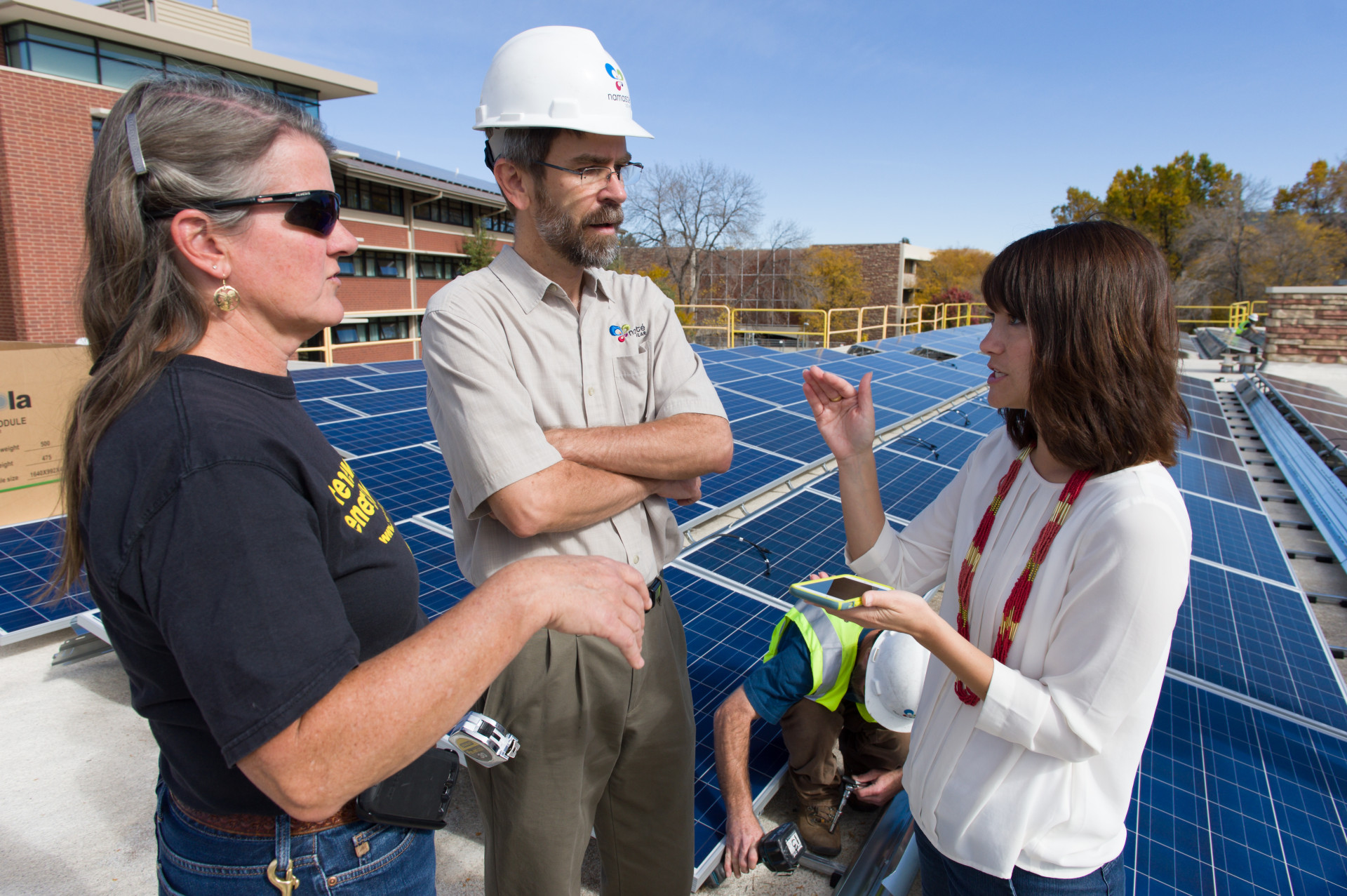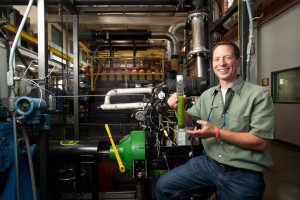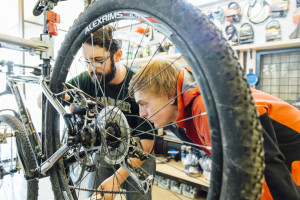
CSU Facilities Engineer Carol Dollard, left, and Tonie Miyamoto, director of communications and sustainability for Housing and Dining Services, discuss the installation of the solar panel array on the roof of Briaden Hall with Rick Cohen of Namaste Solar.
Sustainability is a fiber woven into Colorado State University’s academic and student experiences, research, operations and outreach, all across campus and throughout its satellite campuses and Extension offices.
A commitment to discovering and implementing efficient ways to use limited resources can be traced back to the founding of the University as a land-grant institution committed to a better understanding of humans and the environment and how the two co-exist.
“As a land-grant institution, sustainability is in our blood,” said Tonie Miyamoto, director of communications and sustainability for CSU’s Housing and Dining Services. “Since our first campus farm opened in 1888, CSU has been dedicated to connecting classroom learning to real-world applications. Through research in our laboratories, field courses at our mountain campus, and more than a dozen sustainability immersion programs across the globe, our faculty and students continue to identify and develop solutions to today’s most pressing challenges.”
The campus farm, founded by Ainsworth Blount in the late 1880s, tested crops to determine what grew best in Colorado’s arid, high-altitude lands. The endeavor spawned the commitment to environmental research that embodies CSU’s investigation into climate, natural resources, alternative fuels, and engineered innovations.
STARS ranking put CSU at the top
 Unlike other institutions, CSU has no central sustainability office. Rather, the commitment is supported by all eight colleges and administrative divisions working together – and the approach works.
Unlike other institutions, CSU has no central sustainability office. Rather, the commitment is supported by all eight colleges and administrative divisions working together – and the approach works.
In March 2015, CSU achieved a sustainability benchmark no other college or university had ever achieved: a platinum designation in STARS (Sustainability Tracking, Assessment & Rating System), a program conducted by the Association for the Advancement of Sustainability in Higher Education. It is considered the most comprehensive and prestigious sustainability performance measurement program in higher education. http://source.colostate.edu/csu-builds-on-its-green-reputation/
Miyamoto and Carol Dollard, CSU’s energy engineer, have been on the front lines of CSU’s STARS efforts. The two co-chair the President’s Sustainability Committee and were among a group of employees dedicated to shepherding CSU through the wide-ranging STARS evaluation process.
“CSU was the first institution in the world to earn a STARS Platinum rating because we have infused sustainability across academics, research, operations, engagement and administration,” Dollard said. “Eighty percent of CSU students bring a bike to campus and 60 percent use their bikes as their primary form of transportation. Ninety percent of our academic departments on campus are engaged in sustainability-related research.”
“I am proud that at CSU sustainability isn’t just a lofty ideal; we live it every day,” Miyamoto said.
Since the STARS designation, CSU has received several collegiate sustainability accolades. BestColleges.com named CSU America’s Greenest University and Sierra Magazine put CSU in the top five in its “Cool Schools” rankings.
“CSU’s commitment to sustainability is strong because it is shared by everyone,” said Lynn Johnson, vice president for University Operations. “Our university community understands that we can always be better when it comes to sustainability, and we are very lucky to have people like Carol and Tonie who have a knack for bringing people together to figure out new solutions to address our sustainability challenges.”
Continuing CSU’s sustainability commitment

Dollard and Miyamoto share more than 25 years of experience working at CSU. Dollard said she has always been interested in sustainability and engineering and harbored a desire to improve the environment around her.
“My drive to make the world a little better/healthier/cleaner — or perhaps a little corner of it that I might have influence on — has been a part of me for so long I cannot really describe what drives it,” she said. “What continues to motivate me are my daughters and grandsons – and the need to leave them a healthy and habitable planet.”
Miyamoto said she takes her inspiration from the students of CSU.
“The passion our students have for sustainability motivates me every day,” she said. “Our students are continually asking questions, taking action and challenging us to go further, and that keeps the work fresh and meaningful.”
The mantle of sustainability has taken various shapes over the decades of University history, and the effort has been championed by individuals who helped shape policy and practice to ensure CSU was moving forward efforts to conserve our natural resources, discover new ways to create and use energy, and teach sustainability theory and practice to students. And there are still many areas CSU can improve.
Generating electricity is currently the biggest contributor to our greenhouse gas inventory, and CSU can seize the opportunity to expand the composting program for its dining centers campus-wide, Miyamoto said. Dollard added that getting the campus community to change behaviors, such as not sitting in an idling car, can push CSU ahead even further.
While the responsibility for reaching sustainability goals is now shouldered by the entire CSU community, it is an effort that will need to be carried long into the University’s future.
“I always say that sustainability is an asymptotic goal,” Dollard said. “For the non-math-geeks, that means we can get closer and closer to being truly sustainable but can never get there.”